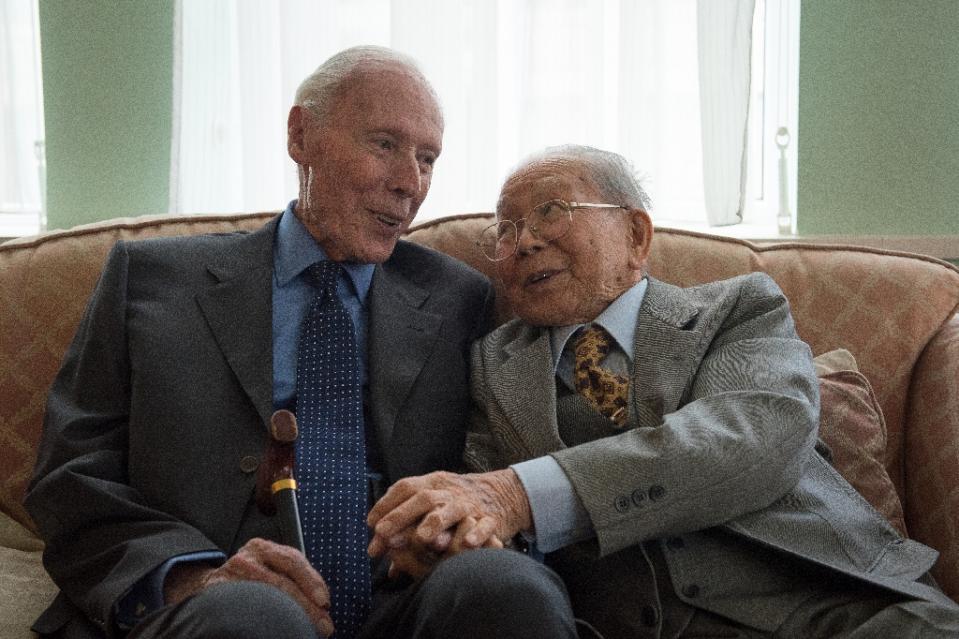ABOVE: World War II vets British army Cpt. Harold Atcherley, 96, and Japanese army engineer Mikio Kinoshita, 94, attend a reception in their honor in central London on Monday. Photo: Leon Neal / AFP
A Japanese engineer on the notorious World War II “Death Railway” in Thailand and a British soldier forced to build the line clasped each other’s hands tightly Monday as they met in reconciliation.
Mikio Kinoshita, 94, and former prisoner of war (PoW) Harold Atcherley, 96, whose Japanese captors made him work as a slave laborer on the track between Burma – modern-day Myanmar – and Thailand, sat quietly on a sofa together as they reflected on their shared experiences.
The two did not cross paths in the 1940s and despite only being able to converse through a translator, the warm rapport between the elderly men, both slowed by age but razor-sharp in mind, was evident at a reception in the Army and Navy gentleman’s club in London.
As the 70th anniversary of the Japanese surrender ending World War II approaches in August, the two men hoped their rare meeting would encourage understanding between those affected by the “Death Railway” – and foster remembrance of the suffering of those who worked and died building the line.
“This evening marks the reconciliation between Mikio Kinoshita and myself. It is 73 years ago since he and I worked on the construction of the Burma-Siam Railway,” said Atcherley, who was then a young army captain.
Citing his former enemy’s empathy, he said it was wrong to judge people for the group they happened to belong to rather than their character.
“We should, I think, remind ourselves that wars are not made by soldiers but by governments,” he said.
Brutality of slave labor
More than 60,000 Allied PoWs worked as slave laborers on the Burma railway line in 1942-43 in brutal conditions. Some 13,000 PoWs and 100,000 indigenous workers died building the line.
The 420-kilometer (260-mile) track linking the Thai and Myanmar railway systems was aimed at resupplying the Japanese army as it fought British colonial forces and their allies.
Kinoshita and Atcherley were among 10 people – five British survivors, five Japanese – interviewed for a documentary by filmmakers HLA entitled “Moving Half the Mountain: Building the Death Railway.”
On seeing it, Kinoshita said he wanted to meet the surviving PoWs and Atcherley invited him to London.
“I feel such a strong bond to you all,” Kinoshita said on meeting the British survivors present.
Conscripted into service, he said he did not experience violence on his section of the line working with Australian PoWs, but when he heard of the “cruel conditions” elsewhere, he felt “deeply saddened.”
He said he personally thanked almost every PoW who worked under him and “even now, I would like to see all of them again.”
‘Enemies can become friends’
Kinoshita, honored by Japan’s emperor for his postwar work in youth crime prevention, said he had attended many memorial services in Myanmar for those who died – 26 times over 39 years.
“When I consider the war, regardless of the winners or losers, it seems it is the people who were involved are the victims. I heartily hope that such sorrow will not be repeated ever again.”
Kinoshita is making the most of his first trip to Europe, trying out fish and chips in a London pub and going for a bus tour of the city.
“It’s a wonderful human story,” Keiichi Hayashi, Japan’s ambassador to Britain, told AFP. “It’s such a long time ago but still we find that there are so many people who lived through the ordeal and want to see their enemy and hold their hand. That should give us a lesson that this sort of tragedy should never happen again.
“Their friendship symbolises the kind of relationship our two countries have managed to cultivate over many years. Bitter enemies can make good friends after understanding each other.”
Story: AFP
Done reading? Kick back and watch Coconuts TV!





Reader Interactions